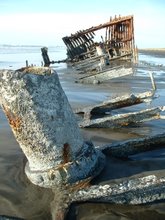Perhaps the physical reason Mt. St. Helens didn't blow towards Portland is because of the south side of the Mountain is reinforced by a very thick layer of hardened lava from previous eruptions. This is, of course, an non-scientific guesstimation.
However, on the second of our Volcano adventure, we explored the South side of Mt. St. Helens. More specifically the "Trail of Two Forests" and the "Ape Caves." Both of these sites display lava influenced geographical features.
The "Trail of Two Forests" features the echoing evidence of a forest once over-run by a lava flow. As the lava flowed from the mountain, it engulfed and devoured large trees. The burning trees left their skeletal imprints in the rock as the lava hardened. Any portion of the trees that survived the fiery destruction lost the battle against natural decay leaving deep holes and tree-trunk tunnels hidden beneath a thriving younger forest. Here you can see a stone 'footprint' memorializing the tree that once filled the hole. You can also see the trunk and root of a younger tree trying to fill the shoes of is ancestor. Many of these holes were deeper than I am tall:
The boys really loved this crawl tube through the ghosts of a few interwoven downed tree trunks. You could see the burning wood grid molded into the walls of the the crawl tube (which weren't well received by the knees):

The "Ape Caves," named after an explorer club known as the "Apes," is the second largest lava tube in the world. Created by flowing lava which later drained out of its self-created tube, the Ape caves reveal the influence of heat and liquid rock flow at differing stages of the flow. A good explanation of these characteristics can be found at the the Oregon Grotto Website: http://www.oregongrotto.com/mtsthelens.shtml
We explored the easier 1/3 of the Ape Caves (3/4 mile walk--one way.) Here are a few pictures of what it looks like inside:

This pictures sort of captures the size of the tube--to think we were walking through a tube once filled with liquid, red, hot rock at the base of a currently active volcano!

This shows the glossy and drippy characteristic of the walls and ceiling of the lava tube.

We found these apes hiding at the end of the tunnel where it narrows to a crawl space filled with sand.







1 comment:
Man, that looks like a great family vacation. What a cool place to visit.
I personally liked the apes that you discovered in the caves.
Post a Comment